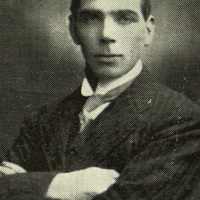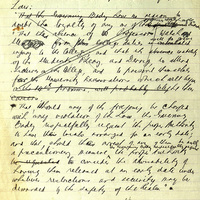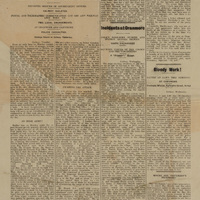The 1916 Rising in Galway Town / Éirí Amach 1916 i mBaile na Gaillimhe
While the Volunteers mobilized a force of over six hundred men in the east Galway countryside, police in Galway town arrested all known republicans, including most of the Volunteer officers and senior IRB men in the town.
Volunteer Thomas Hynes recalled that, ‘as far as the city was concerned it was too late to do anything.’ Cut off by rail and road from the rest of the country and with telegraph lines sabotaged, news of rebel activity in the east Galway countryside created a sensation in Galway town, with rumour and hysteria quickly taking hold. All business premises closed their doors and all work in the town came to an immediate stop. Amid fears of a repetition of events in Dublin, the post office was placed under armed guard and a notice of martial law was posted instructing that all licensed premises in the urban district were to remain closed and that all persons were to remain indoors between the hours of eight at night and five in the morning.
Members of the Redmond’s National Volunteers were explicitly exempted from the emergency regulations. The military curfew was greatly resented for adding to the sense of hysteria in the air. The Connacht Tribune stated:
Men were no longer able to concentrate their minds on their business, and all and sundry fairly took to the streets. Comfortable merchants went about and the streets were filled. Preparations were made for meeting and repelling the invasion and anxious people found themselves drifting towards the Square and looking in the direction of Oranmore and keeping a close eye from Forster Street.
On Wednesday night in the Town Hall, a public meeting called by the Urban Council attracted a large crowd. A ‘Committee of Public Safety’ was duly formed to liaise with and support the Crown Forces and to organize a concerted civilian response. Throughout the week, meetings of the ‘Committee of Public Safety’ were held on a daily basis at the Town Hall amidst growing anger at the perceived isolation of the town, potential food rationing measures, and the fear of an impending ‘bread famine’. A speaker told the gathering at the inaugural meeting: ‘Irishmen as a rule are not fools but unfortunately a large number of young men throughout the country were led astray by gentlemen who should know better and he for one did not blame the ignorant countrymen.’ One of several Catholic priests who spoke at the meeting, Fr Davis, agreed, adding ‘they have been led into a trap and it is only afterwards when a settlement is reached, that they will realise what a mistake they have made in supporting the hot heads of the country.’ Another speaker expressed the widespread sentiment that the rebels were ‘a movement not for the benefit of Ireland, but for Prussia and the leaders must be taught a lesson they’d remember forever.’ Professor Kinkead from the University saw the hand of the Germans at play and he believed, ‘the whole thing was engineered with German money, for German purposes.’
A naval vessel began bombarding the Galway coastline on Tuesday and the sound of the first four-inch shells increased the sense of anxiety in the town. The boom of the big guns could be heard by the rebels twelve miles away in Athenry, further fuelling rumours that Oranmore and other ‘rebel villages’ were being bombarded. A rumour that a naval battle was taking place between German u-boats and the British Fleet was widely believed. The shelling provoked terror in the communities living around Galway Bay and people began to flee to the perceived safety of the town.
Volunteer Thomas Hynes, the centre of the College’s small IRB cell, later recalled:
There was a great confusion. We did not know what to do and, as far as Galway city was concerned, it was late to do anything as RIC and military were already alerted. It was our intention to take a few prominent men, Martin MacDonogh, Joe Young, etc., and occupy the post office. This was George Nicholls’ plan. He seemed to know more about what they intended to do in Dublin than the rest of us did. There was actually only three men left Galway to join Mellows at Carnmore, a boy named McDermott, J. Corbett and another. The rest of us were acting on strict IRB instructions from Mellows and he had more than he could manage, as he had not arms and ammunition for half his men.

George Nicholls, the Irish Republican Brotherhood centre for Galway town, was arrested during the Rebellion

Brian Cusack was a medical graduate of UCG and was elected to the first Dail as a Sinn Fein representative for North Galway in 1918. He was a founder member of the Volunteers in Galway and was deported in May 1918, and again during the War of Independence.
Éirí Amach 1916 i mBaile na Gaillimhe
Chuir na hÓglaigh buíon os cionn sé chéad fear le chéile in oirthear na Gaillimhe agus ag an am céanna ghabh na póilíní gach poblachtánach aitheanta i mbaile na Gaillimhe; bhí formhór na n-oifigeach sna hóglaigh agus formhór na bhfear sinsearach san IRB ina measc.
Ba chuimhin leis an Óglach Thomas Hynes, ‘as far as the city was concerned it was too late to do anything.’ Ní raibh iarnród ná bóithre acu chuig an gcuid eile den tír agus bhí na línte teileagraf gearrtha, ach nuair a chuala muintir na Gaillimhe go raibh reibiliúnaithe gníomhach in oirthear an chontae bhí caint, luaidreáin agus scéin i mbarr réime. Dhún na gnónna ar fad a ndoirse agus tháinig stop leis an obair ar fad ar an mbaile. Bhí faitíos go dtarlódh an rud céanna a tharla i mBaile Átha Cliath. Cuireadh oifig an phoist faoi gharda armtha agus fógraíodh dlí míleata a d’ordaigh go gcaithfeadh gach áitreabh cheadúnaithe sa chathair fanacht dúnta agus go gcaithfeadh gach duine fanacht istigh idir a hocht san oíche agus a cúig ar maidin.
Ní raibh ar Óglaigh Náisiúnta Redmond cloí leis na rialacháin éigeandála seo agus bhí daoine go láidir i gcoinne an chuirfiú mhíleata, rud nár chuidigh leis an scéin a bhí le brath san aer; tuairiscíodh sa Connacht Tribune:
Men were no longer able to concentrate their minds on their business, and all and sundry fairly took to the streets. Comfortable merchants went about and the streets were filled. Preparations were made for meeting and repelling the invasion and anxious people found themselves drifting towards the Square and looking in the direction of Oranmore and keeping a close eye from Forster Street.
Oíche Dé Céadaoin thionóil an Chomhairle Ceantair Baile cruinniú poiblí agus d’fhreastail os cionn céad duine air i Halla an Bhaile. Cuireadh coiste um Shábháilteacht an Phobail le chéile le dul i dteagmháil le Fórsaí na Corónach agus tacú leo agus freagra ceart, comhaontaithe a eagrú ó na daoine. I rith na seachtaine, bhí cruinnithe ag an gCoiste um Shábháilteacht an Phobail gach lá i Halla an Bhaile agus bhí daoine ag éirí feargach faoin gcaoi ar bhraith siad an baile a bheith scoite amach. Bhí imní orthu go mbeifí ag ciondáil bia agus go bhféadfadh ganntanas mór aráin a bheith ann dá bharr. Dúirt cainteoir amháin leis an slua ag an gcéad chruinniú nárbh amadáin iad na hÉireannaigh, ach faraoir, go raibh go leor fear óg curtha ar bhóthar na haimhleasa ag fir uaisle ar chóir go mbeadh fios a ngnó acu agus nach raibh aon mhilleán aige féin ar na fir thuaithe shoineanta seo. D’aontaigh an tAthair Davis, duine de na sagairt Chaitleaceacha a labhair ag an gcruinniú, leo, á rá, ‘they have been led into a trap and it is only afterwards when a settlement is reached, that they will realise what a mistake they have made in supporting the hot heads of the country.’ Dúirt duine eile an rud a bhraith go leor: gurbh éard a bhí sna reibiliúnaithe ná gluaiseacht ar son na Prúise agus gur chóir ceacht a mhúineadh do na ceannairí nach ndéanfaí dearmad go brách air. Bhraith an tOllamh Kinkead as an Ollscoil go raibh lorg na nGearmánach le sonrú agus chreid sé, ‘the whole thing was engineered with German money, for German purposes.’
Thosaigh árthach cabhlaigh ag ionsaí chósta na Gaillimhe ar an Máirt agus chuir torann na gcéad sliogán leis an scéin ar an mbaile. Bhí torann na ngunnaí móra le cloisteáil ag na reibiliúnaithe dhá mhíle dhéag ó bhaile i mBaile Átha an Rí, ag cur leis na luaidreáin go raibh Órán Mór agus bailte ‘reibiliúnacha’ eile á n-ionsaí. Creideadh go láidir an luaidreán go raibh cogadh cabhlaigh ar bun idir u-bháid na Gearmáine agus Cabhlach na Breataine. Chuir na hionsaithe uafás ar mhuintir na mbailte timpeall Chuan na Gaillimhe agus thosaigh daoine ag éalú isteach sa bhaile áit ar bhraith siad níos sábháilte.
Dúirt an tÓglach Thomas Hynes, a bhí i gcroílár bhuíon bheag IRB an Choláiste, an méid seo a leanas ina dhiaidh sin:
There was a great confusion. We did not know what to do and, as far as Galway city was concerned, it was late to do anything as RIC and military were already alerted. It was our intention to take a few prominent men, Martin MacDonogh, Joe Young, etc., and occupy the post office. This was George Nicholls’ plan. He seemed to know more about what they intended to do in Dublin than the rest of us did. There was actually only three men left Galway to join Mellows at Carnmore, a boy named McDermott, J. Corbett and another. The rest of us were acting on strict IRB instructions from Mellows and he had more than he could manage, as he had not arms and ammunition for half his men.


